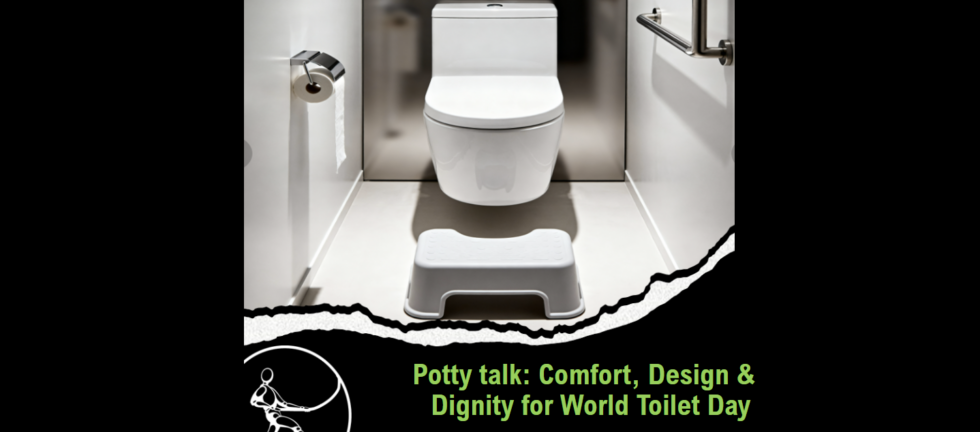On Wednesday this week, we will celebrate “World Toilet Day.” (I’m not making this up.) You’re probably wondering how I’m going to connect toilets and ergonomics, but toilets actually offer many “fitting equipment to human” considerations.
- Design and accessibility
You might think that your toilet is uniquely fitted to your own derriere, but I can assure you that one toilet is not comfortable for all users. Factors like seat height, width and length, hand rails, and the space around the toilet are important, particularly for the elderly, people with disabilities, and children. A raised seat is easier to get on and off, but can be a circulation-killer for short folks with long sitting times. Grab bars become important as we age – no one wants to ask for help to get up from the toilet if they are capable of exiting on their own. We’ve all experienced frustration (or perhaps even rage) when the toilet paper was not accessible, or the spare rolls were out of reach. And let’s touch only briefly on heated seats, cushioned seats, and bidets.
In your own home, choose a toilet size and design that fits the users, carefully consider the placement of toilet paper, and ensure that the space around the toilet can accommodate grab rails if you need them in the future.
- Posture and health
I’ve already mentioned how toilet height affects the ease of sitting and standing, and how seat design affects comfort during a long session in the reading room. But we all know how Elvis died. Toilet design also affects biomechanics during strenuous evacuation events. (https://pmc.ncbi.nlm.nih.gov/articles/PMC12219158/). In a “scoping review” (pardon the pun), Rahgoshay et al. reported that, “Squatting may reduce digestive strain and enhance bowel evacuation, potentially benefiting constipation.” Squatting postures, with the knees higher than the hips are more “movement-friendly” than sitting positions, but uncomfortable for long periods of time.
Having a footstool available in the bathroom can help adults. Put it there when you have small kids in the house, to serve a dual purpose. 😊
- Workplace ergonomics
Most workplaces offer workers short morning and afternoon breaks. A well-hydrated person is going to need the restroom during at least one of these breaks. If breaks are not staggered, that means that everyone needs to march across the plant to the toilets at the same time. If you have ever been to a bar, you know that the line to the ladies’ room usually snakes out toward the dancefloor. We take longer. And no one wants to use their entire break standing in line. If it is not possible to use the restroom during breaks, women will “hold it,” and that can lead to a host of new health issues. Not to mention that no one can focus on their work with an exploding bladder.
Workplaces need to ensure that ample facilities are available for the number of people who will need to use them, and that they are conveniently located to promote their use during short breaks.
Bathrooms ARE workplaces for some caregivers. In healthcare and long-term care facilities, bathrooms may be designed to accommodate lifts and other assistive devices, and to allow space for a care provider. But homes are not. If a care provider needs to help a resident or patient in a private home setting, the challenges are numerous. The next time you use your own restroom, ask yourself where you would like a helper to stand, to assist you with the tasks that you perform there.
Homes should be designed to allow access around the toilet, so a helper can be of assistance when needed.
Bathrooms are also workplaces for those who clean, and this job can also be affected by toilet design. Cleaning demands can be defined by the contours and crevices in the design, whether the seat stays up on its own or must be held up, whether the seat drops slowly or slams when released, and whether furniture or equipment crowds the porcelain.
Consider how you will clean a toilet when you choose its features, and when you decide where to store your plunger, cleaning brush, towels, and spare rolls.
World Toilet Day highlights the global need for safe, dignified sanitation. Applying ergonomics can ensure that toilets are designed to optimize safety, accessibility, comfort, and maintainability for all users.
Reference: Rahgoshay N, Rahdar M, Nikoo L, Daneshmandi H. Sitting vs. squatting: a scoping review of toilet postures and associated health outcomes. BMC Public Health. 2025 Jul 2;25(1):2192. doi: 10.1186/s12889-025-23379-8. PMID: 40604598; PMCID: PMC12219158.


